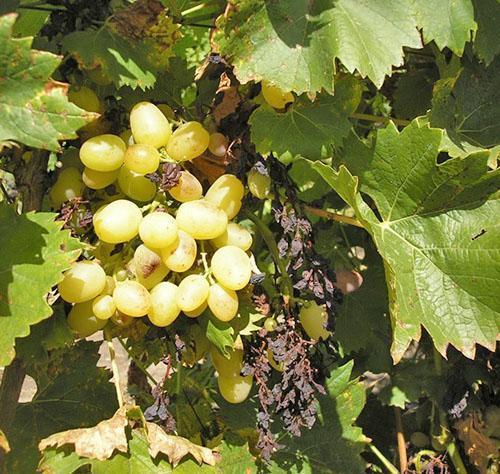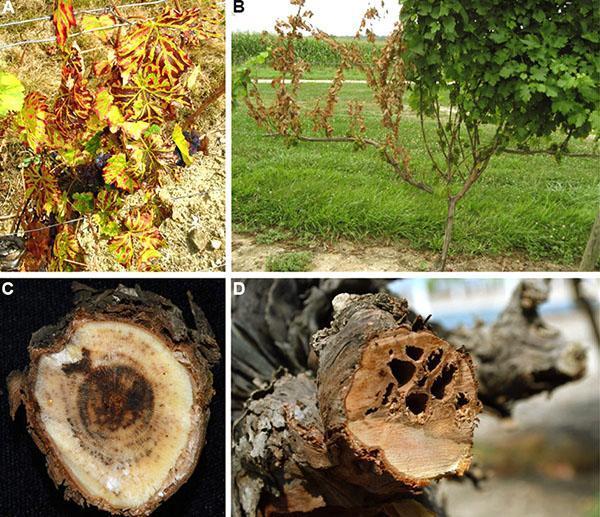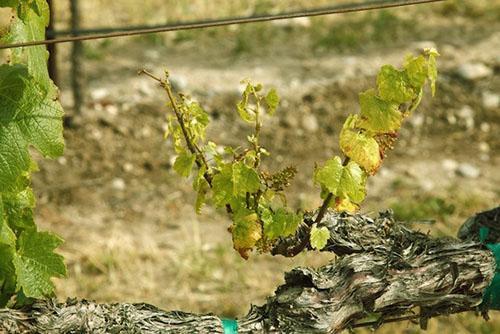Why do grapes dry?
 Disease and pest infestation in the vineyard often causes serious damage to the vine. If the leaves dry on the grapes, the shoots wither and die off, this becomes a heavy loss for the grower. The trouble is twice as big when the brushes suffer, the berries dry up and a significant part of the harvest is lost. Moreover, the drying process can begin both immediately after setting the berries, and already during their ripening, be accompanied by symptoms inherent in cultural diseases, and proceed for no apparent reason.
Disease and pest infestation in the vineyard often causes serious damage to the vine. If the leaves dry on the grapes, the shoots wither and die off, this becomes a heavy loss for the grower. The trouble is twice as big when the brushes suffer, the berries dry up and a significant part of the harvest is lost. Moreover, the drying process can begin both immediately after setting the berries, and already during their ripening, be accompanied by symptoms inherent in cultural diseases, and proceed for no apparent reason.
Why do berries dry on grapes? There are many reasons for the loss of bunches. Most often, growers identify diseases caused by pathogenic fungi.
Downy mildew is in the first place in terms of harmfulness, affecting not only the ridges and clusters of grapes, but also the green mass, new and perennial shoots. The fungus, penetrating into the tissues of the plant, prevents the flow of food and moisture. Infected parts of the vine, including brushes and ripening berries, dry out and die.
Mildew - this is not the only problem that threatens with loss of crops. There are other diseases of grape berries, photos with the action of which on the vine clearly prove the degree of danger and the need to combat them. Insect pests can cause serious damage to the crop, there is a risk of losing berries and in case of insufficient vineyard care.
Dry-handed grapes

Since the pathogenic fungus is able to penetrate the tissues of not only grapes, but also many other horticultural and fruit crops, this complicates the fight against the manifestations of the disease and its spread. The disease affects not only shoots and berries, changes in wood caused by the fungus are clearly visible in the photo of grape disease. The disease especially affects adult grape bushes, aged from 8 years, and the symptoms of dry arms become apparent when the plant at the beginning of summer grows 20-25 cm long.
 Shoots and leaves are lagging behind in growth, oh, the size and color are different from healthy ones. The leaves dry on the grapes, and then necrosis affects the affected shoots. The set berries dry up or stop growing, and remain small until the end of the growing season.
Shoots and leaves are lagging behind in growth, oh, the size and color are different from healthy ones. The leaves dry on the grapes, and then necrosis affects the affected shoots. The set berries dry up or stop growing, and remain small until the end of the growing season.
Spotted anthracnose grape
 One of the reasons why grapes dry out may be anthracnose. The peak of infection with this serious disease occurs during wet periods, and the pest is active not only in warm weather, but in the range of 2-30 ° C.
One of the reasons why grapes dry out may be anthracnose. The peak of infection with this serious disease occurs during wet periods, and the pest is active not only in warm weather, but in the range of 2-30 ° C.
Manifestations of anthracnose are often mistaken for mechanical damage to berries and shoots caused by hail. But the weather has nothing to do with it.
Rounded necrotic spots with a brown-black border are the zones of penetration of harmful fungi. Such spots can merge, the dried up affected tissues inside them are destroyed, and the young leaves drying on the grapes seem to be burnt.
 The disease infects all aboveground green plant organs, including the brushes. The grape disease, in the photo, presents the greatest danger to berries before flowering, when the entire brush is affected, and also before the harvest ripens. As the disease progresses, spots characteristic of the disease form on the ovaries and ridges, after the growth of which the brush withers in whole or in part.
The disease infects all aboveground green plant organs, including the brushes. The grape disease, in the photo, presents the greatest danger to berries before flowering, when the entire brush is affected, and also before the harvest ripens. As the disease progresses, spots characteristic of the disease form on the ovaries and ridges, after the growth of which the brush withers in whole or in part.
Verticillary wilting of the vine
 Verticillium, the causative agent of this disease, the pathogenic fungus Verticillium dahliae, penetrates the roots through the soil and, multiplying, disrupts the supply of moisture to the shoots and bunches of grapes. The disease of grape berries, as in the photo, more often and more strongly affects young plants, and its external manifestations can become visually noticeable only a year or two after infection.
Verticillium, the causative agent of this disease, the pathogenic fungus Verticillium dahliae, penetrates the roots through the soil and, multiplying, disrupts the supply of moisture to the shoots and bunches of grapes. The disease of grape berries, as in the photo, more often and more strongly affects young plants, and its external manifestations can become visually noticeable only a year or two after infection.
 The vineyard suffers the strongest damage when the bushes are under high stress. This is more often observed with a lack of moisture, elevated air temperature and the beginning of ripening of berries. First, leaves that look like burnt dry on the grapes, then the turn of shoots and bunches comes. The clusters located in the lower tiers of the affected shoots dry, individual berries on the grapes dry, mummify and remain in this form on the bunches.
The vineyard suffers the strongest damage when the bushes are under high stress. This is more often observed with a lack of moisture, elevated air temperature and the beginning of ripening of berries. First, leaves that look like burnt dry on the grapes, then the turn of shoots and bunches comes. The clusters located in the lower tiers of the affected shoots dry, individual berries on the grapes dry, mummify and remain in this form on the bunches.
Buffalo leafhopper
Buffalo leafhopper, which increasingly attacks vineyards, can inflict no less harm than pathogenic fungi.
 An insect that feeds on plant juices, on the shoots and ridges, makes characteristic ring-shaped lesions, up to a centimeter long, as a result of which the grapes, which are not receiving enough nutrition, dry up, the shoots wither and die off.
An insect that feeds on plant juices, on the shoots and ridges, makes characteristic ring-shaped lesions, up to a centimeter long, as a result of which the grapes, which are not receiving enough nutrition, dry up, the shoots wither and die off.
The pest gives one generation per season. In the stage, leafhoppers larvae live and feed on grassy plants under vine bushes, and then adult insects climb the vine and begin their harmful activity.
 The abundance of vegetation near the vine bushes contributes to the spread of the pest. A measure of the fight against a dangerous insect is a double treatment of plants with benzophosphate. Such spraying should be carried out in June, and, in addition, removing weeds and planting beds with onions and garlic near the vineyard, which frightens off leafhoppers, will be a good prevention.
The abundance of vegetation near the vine bushes contributes to the spread of the pest. A measure of the fight against a dangerous insect is a double treatment of plants with benzophosphate. Such spraying should be carried out in June, and, in addition, removing weeds and planting beds with onions and garlic near the vineyard, which frightens off leafhoppers, will be a good prevention.
Bending of the ridges during berry ripening
 An explanation of why berries dry on grapes can be the ripening bunches themselves, under whose weight the bunches bend, the supply of moisture and nutrients is disturbed and the fruits wither.
An explanation of why berries dry on grapes can be the ripening bunches themselves, under whose weight the bunches bend, the supply of moisture and nutrients is disturbed and the fruits wither.
The risk of loss of yield for this reason is greatest for varieties and hybrids that form heavy large clusters.
You can avoid breaking the ridges and shoots bearing brushes if you grow a bush based on an arch or a gazebo. The brushes hanging down are not constrained and develop well, and the branches experience an even load and do not bend.
Drying grape ridges
 If no apparent reasons, for example, symptoms of diseases of grape berries, as in the photo, have been identified, and the brushes are not poured, and the berries are mummified, perhaps we should talk about drying out of the ridges.
If no apparent reasons, for example, symptoms of diseases of grape berries, as in the photo, have been identified, and the brushes are not poured, and the berries are mummified, perhaps we should talk about drying out of the ridges.
This phenomenon, first noticed a little more than a century ago, has not yet been sufficiently studied; it has only been found out that a kind of paralysis, leading to a slowdown or arrest of the development of bunches, is associated with metabolic disorders and is of a local nature. The disease is not infectious in nature, is not transmitted to other plants and may be associated with a violation of the ingress of moisture through the vessels of the ridge to the ripening berries. Indeed, it is during dry periods that paralysis, leading to the drying out of grapes, is most often manifested.
Symptoms preceding drying, in the form of brown dark spots at the branches of the ridge, become noticeable during the ripening period, when the berries accumulate from 7 to 12% sugar.
The tissues under the spots are affected to the depth of several layers of cells, and the lack of moisture aggravates the picture and necrosis covers all new areas. If the spot on the ridge loops back, the flow of moisture to the brush located below stops, and the isolated grapes dry out, wrinkle and lose their taste and marketability.
Drying of the grape ridges is dangerous not only with the loss of harvest, but also by the fact that mold and disease-causing fungi often settle in the affected areas, causing secondary infection of the culture.
 No direct relationship was found between the frequency of drying of the ridges, the region of growth and the grape variety.But empirically, it was possible to determine that self-rooted bushes are less likely to be affected by this disease of grape berries, as in the photo, than grafted plants, especially on vigorous rootstocks.
No direct relationship was found between the frequency of drying of the ridges, the region of growth and the grape variety.But empirically, it was possible to determine that self-rooted bushes are less likely to be affected by this disease of grape berries, as in the photo, than grafted plants, especially on vigorous rootstocks.
Treatment of paralyzed bushes with fungicides or other plant protection products is ineffective. In some cases, when the grapes dry out, spraying the plantings with a 0.75 percent solution of magnesium chloride or 3 percent magnesium sulfate helps. Prophylaxis begins about a month before the onset of paralysis, and then two more sprays are carried out with an interval of 10 days.
As an effective prevention, when the berries begin to take on color and gain juice, the bunches and the surrounding area are treated with a 5% solution of magnesium sulfate.
However, the main means of combating the drying out of grape ridges, gardeners consider compliance with the rules of agricultural technology. Only with proper formation and pruning vines, the use of balanced fertilizing, including magnesium and a moderate amount of nitrogen, as well as with sufficient watering of the vineyard in combination with treatment with chemicals, one can talk about eliminating paralysis of the ridges and saving the crop.
Please tell me why the bunch of grapes is not full of berries? Almost all the grapes are so ugly, on each cluster there are 5-10 berries, the rest are small green dots.
This is one of the diseases of grapes - peas. Read the article on grape diseases. Another video article to help you https://myvilla.decorexpro.com/en/kak-izbezhat-gorosheniya-vinograda/
Good day. Please help me to identify the disease of grapes and what can be done !?
The plant is affected by mildew. Read about the ways of struggle and prevention https://myvilla.decorexpro.com/en/bolezni-vinograda-po-foto-i-opisaniyu/
Please tell me what is it?
Verticillary wilting of the vine. Read the article for what to do.
Hello. Help determine if this is a disease and what to do?
The defeat of berries by powdery mildew. Now it will not be possible to save the harvest. After the leaves have fallen off, they are treated with copper sulfate. In the spring, before the kidneys swell, the same treatment is carried out. Further treatment is carried out with hydrogen peroxide as a preventive measure.
Good evening. Please tell me what's wrong with the grapes!
This is chlorosis. The plant is deficient in iron. Must be treated with iron chelate.
Thank. And with berries like this
good day! please look at the photo and tell me what happened to our grapes and how to save them. They hadn’t been at home for a month, when they arrived, they saw that the leaves were disappearing and the unripe poured berry was crumbling. Thanks in advance for your prompt reply and recommendations
There is a whole range of problems that are difficult to deal with. You won't be able to save the harvest. If you can donate fruit, treat it with fungicides. After the foliage has fallen off, prune the unripe vine and treat the bushes with copper or iron sulfate. In the spring, after trimming and cleaning, re-process. The solution is used 3%. It is better to do prevention than to waste energy fighting.
Tell me what is the reason for the wilting of the berries. Variety Moldova.
The same question. Moldova grapes. Gradual wilting of all bunches. Sevastopol.
The grapes are particularly affected this year. The reason is a sharp change in temperature, heavy rains and bright sun. All who have not paid attention to disease prevention lose their harvest. Need spring and autumn processing with copper or iron sulfate. After the vines grow more than 25 cm, periodically carry out treatment with hydrogen peroxide at the rate of 300 ml per 10 liters of water. Not less than 6 treatments per season.This saves the harvest. In the photo, bacterial wilting, oidium damage, moniliosis. Diseases occur in a group, which makes it impossible to preserve the harvest.
Help cure grapes
It is too late to fight grape disease now. I usually pick good berries, wash them thoroughly and we eat them. There are no chemicals in them, which is good. Remove all clusters from the bush, and after the leaves fall, treat with a 3% solution of copper or iron sulfate. In the spring, repeat the treatment after pruning until bud break. As soon as the new vine reaches a length of 20-30 cm, start a series of treatments with hydrogen peroxide. For 10 liters of water, you need 300 ml of pharmacy peroxide. During the season, at least 6 treatments, and with frequent rains after each heavenly watering. The result is excellent. The grapes are resistant to all diseases, the harvest is pleasing to the eyes, and the bunches are simply amazing. However, no chemicals.
don't mildew drugs kill anthracnose?